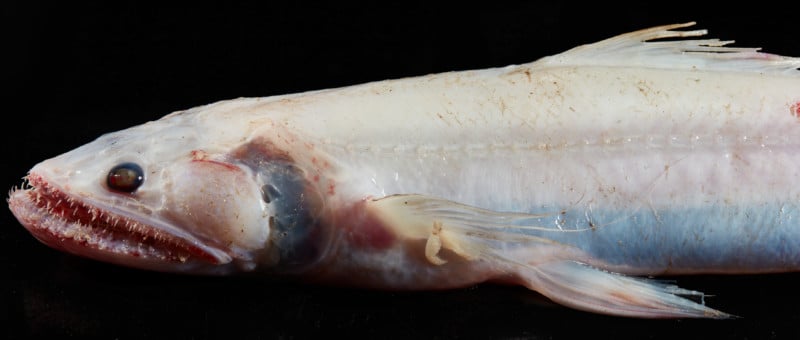Photos of Newly Discovered Deep-Sea Creatures Living in the Remote Ocean

These photos show newly discovered deep-sea creatures living in the far reaches of the Indian Ocean close to underwater volcanos.
The bizarre fish were uncovered during an expedition to Austalia’s remote Cocos (Keeling) Islands Marine Park by scientists from the Museums Victoria Research Institute.
The team surveyed previously unknown deep-sea life in the Indian Ocean and collected samples from as deep as five kilometers below the surface.

Among the never-before-seen specimens is a blind eel with gelatinous skin that gives birth to live young, unlike most fish which lay eggs. The eel was discovered at a depth of five kilometers with the researchers noting their poorly developed eyes.
The team also came face-to-face with a Highfin lizard fish, a voracious deep-sea predator with a mouth full of long sharp teeth. They are a hermaphrodite species with functional male and female reproductive tissue simultaneously.


Far cuter are the deep-sea batfishes that amble over the seafloor on their arm-like fins. They use a tiny “fishing lure” in a small hollow on their snout to attract prey.
However, the majority of deep-sea fish tend to look nightmarish and the Sloane’s Viperfish is a great example of that, with its huge fang-like teeth that are visible even when the mouth is closed. Viperfish also have rows of light organs along the underside and a very long upper fin with light organs on the tip to attract prey.




Also found was a flatfish from the order Pleuronectiformes, which has both eyes on one side of its head to retain vision while lying camouflaged on the seabed.
“We have discovered an amazing number of potentially new species living in this remote marine park,” says Museums Victoria Research Institute’s Dr. Tim O’Hara, Chief Scientist of the expedition.
“We are proud that our maps, data, and images will be used by Parks Australia to manage the new marine park into the future.”
Mapping the Ocean Floor
Aside from collecting fascinating deep-sea samples and photographing them, the team also produced detailed three-dimensional images of the massive mountain underneath the Cocos (Keeling) Islands themselves, which has never been mapped in detail before.


“We’ve used the full ocean depth mapping capabilities of RV Investigator to completely survey around the Cocos (Keeling) Islands, from coastal depths less than 100m all the way down to the abyss some 4800m below,” says Nelson Kuna, one of two Hydrographic Surveyors on board.
“The data set now covers a substantial area of the new marine park and shows the Cocos (Keeling) Islands as the twin peaks of a massive seamount that rises nearly 5,000m from the surrounding seafloor,” he adds.
“It’s truly an honor to see, for the first time, these stunning features revealed from the deep.”
Image credits: All photos by Benjamin Healley/Museums Victoria.